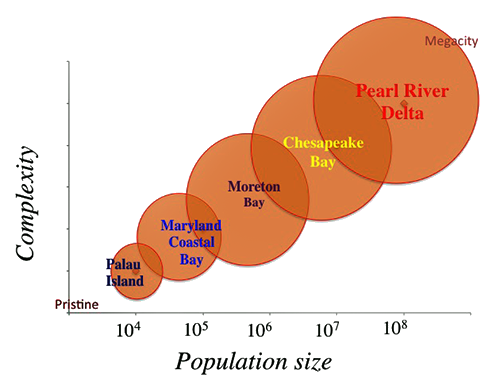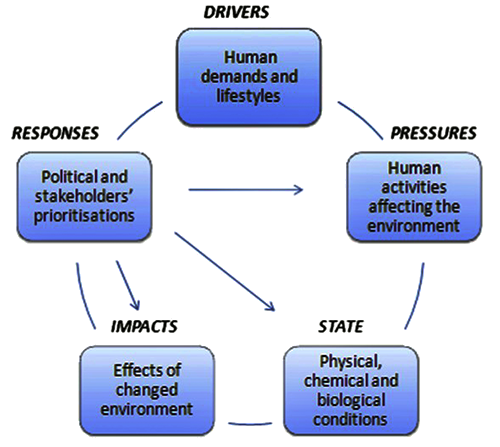Population and Environment Case Studies: Local Approaches to a Global Challenge
Chih-Hsien (Michelle) Lin, Detbra Rosales, Melanie Jackson ·Chih-Hsien (Michelle) Lin, Detbra Rosales, Melanie Jackson
It is apparent that we now live in a new epoch, the Anthropocene (IGBP, 2001), in which Earth’s environment and climate is mainly controlled by human activity. Environmental damage is accelerating on a global scale. As the world’s population increases, improving standards of living without destroying or degrading the natural environment becomes a challenge. Water shortages, sea-level rise, air pollution and degradation of coastline afflict many areas all over the world.
The larger the population, the more complex the environmental problems become (Fig. 1). The challenge is to build synergies between members of separate disciplines and between scientists, policymakers and the public within and between nations that can accomplish collaboratively what none are capable of doing alone for global climate change. A number of case studies in the coastal zone, based on population density gradients, from Palau, Maryland Coastal Bays, Moreton Bay in Australia and Chesapeake Bay to Pearl River in China will be reviewed to understand the population dynamics, environment issues, and management services. Importantly, through this case study discussion, we can learn from different perspectives between nations and the mistakes in terms of the environment and quality of living.

Palau is not letting the overwhelming climate change impacts slow them down. The Pacific country of Palau (with a population of only 21,000) has made significant environmental inroads to a pristine ecosystem protection and a sustainable tourism-based economy. They are looking for ways to increase the resilience of their diverse mangroves, seagrasses and coral reefs to promote high-end ecotourism and manage development to protect its unique ecosystem. However, managing conflicts between conservation, tourism and traditional practices are inevitable in Palau. For example, how do we push to develop education awareness of ecological processes and sustainable development to the public? How do we overcome the knowledge gap, culture differences and language barriers before educating local people about global climate change? How do we spread awareness of the environmental problems when it brings people into closer contact with nature via ecotourism? It is obvious that Palau needs international support and lessons from different experiences and perspectives for management, monitoring and research. A comparison between regions (such as tropical versus temperate environments) is necessary, but it should be careful not to extrapolate too much. Culture bias on nutrient pollution and marine impacts on different systems must be taken into account when making environmental decisions.
The Maryland coastal bay, Chincoteague Bay lagoon system is a wave-dominated environment. The changes impacting water quality, land use and the ecosystem have been associated with intensification of anthropogenic stressors (Fertig et al. 2013) Non-linear ecosystem level changes are due to the complexity of the phenomena occurring in this system. Therefore, management of coastal ecosystems requires a strong interaction between managers and researchers (Dennison 2008). Problem-oriented research is an effective way to examine the sustainable use of coastal zones, and targeting proper species that can affect human health directly is also important for implementing research. The aim of research is to translate it into meaningful information for the decision-making process or its evaluation.
The Moreton Bay system in Australia is known for seagrasses, mangroves and coral diversity. The bay is special in that wildlife is close to city skyline. The health of the bay had worsened over the past year due to the growing population along the coastlines. A significant component of nitrogen pollution from sewage discharge leads to marine eutrophication (Costanzo et al. 2001). Scientists researching water quality issues have developed an ecosystem health index for assessing the health of Moreton Bay. Functional zones based on habitats are also well defined to process effectiveness assessment. On the other hand, the scientists working in Moreton Bay have had good support from politicians, which has enhanced the communication with the public. The Queensland government and mayor are big advocates of the idea that the more people hear the problems, the more they get behind the actions. Currently, they yield good result: the receiving sewage discharge used to be seven times higher than the water quality standards in Queensland; however, it is currently only about two times the standard.

The drivers-pressures-state-impacts-responses (DPSIR; Fig. 2) framework provides a standard framework for site assessment and evaluation on the effect of human activity on environment. The framework has been applied to study the complex interactions in Chesapeake Bay and China’s megacity around Pearl River. The rapid rate of population growth around Chesapeake Bay watershed has changed the land use and expanded urban areas. Harmful algal blooms, declines in oyster population, land erosion and invasive species have become major environmental issues here. Although the Chesapeake Bay is extremely well studied; effective communication between science and management is required to bridge the barriers to integration (Boesch 2006). While the Chesapeake Bay is extensively managed with multiply branches; the community involvement and partnership are commonly separated. People do not feel a sense of ownership for the bay.
Population growth in China is formidable. The economic imbalances within the country itself result in a huge and constant influx of migrants to the coastal megacity (defined as a city with more than 10 million people in search of better jobs and quality of living). China’s Pearl River Delta region has overtaken Tokyo as world’s largest megacity. Large population pressures on resources cause devastating effects on natural environments and human health. As megacities grow, the boundaries expand. It is difficult to manage efficiently when cities reach unprecedented scales and complexity beyond population models. Although the urbanization rate of this coastal megacity has been slowing down, there are a number of uncertainties in terms of nutrient contaminants and future climate change.
Governments around the world are moving to integrate their efforts to address complex environmental issues, such as the Kyoto Protocol. However, there are many challenges we must face in order to make this possible, and to working together across-boundaries can range from technological applications, such as data to culture bias in science and organization. Science may have good networking through peer review, but integrative management is not easy to conduct.
References:
- IGBP (2001) Global Change and the Earth System: a Planet Under Pressure. In: IGBP Science, No. 4. International GeosphereeBiosphere Programme, Stockholm, Sweden, p. 32.
- Boesch DF (2006) Scientific requirements for ecosystem-based management in the restoration of Chesapeake Bay and Coastal Louisiana. Ecological Engineering 26:6-26 [pdf]
- Costanzo SD, O’donohue MJ, Dennison WC, Loneragan NR, Thomas M (2001) A new approach for detecting and mapping sewage impacts. Marine Pollution Bulletin 42:149-156
- Dennison WC (2008) Environmental problem solving in coastal ecosystems: A paradigm shift to sustainability. Estuarine, Coastal and Shelf Science 77:185-196 [pdf]
- Fertig B, O'Neil JM, Beckert KA, Cain CJ, Needham DM, Carruthers TJB, Dennison WC (2013) Elucidating terrestrial nutrient sources to a coastal lagoon, Chincoteague Bay, Maryland, USA. Estuarine, Coastal and Shelf Science 116:1-10
- Sekovski I, Newton A, Dennison W (2011) Megacities in the coastal zone: Using a driver-pressure-state-impact-response framework to address complex environmental problems. Estuarine, Coastal and Shelf Science xxx (2011) 1-12
Next Post > Kick-starting Collective Impact in Five Easy Report Card Steps
Comments
-
Stephanie Siemek 11 years ago
I agree with the statement, “The larger the population, the more complex the environmental problems become…”, as this idea can be supported within our own personal experiences on how difficult it is to accommodate a large group of people. For instance, how difficult is it for a large group of friends to all agree on what to do on Friday night? Each person has different ideas, needs, and opinions. Therefore, how can it be possible for multiple leaders, states, countries etc. to form an agreement that will restore and sustain the Earth’s ecosystems?
Worldwide collaboration and understanding is necessary for conservation and recovery of ecosystems, as nature has no boundaries. Therefore, it will be up to our leaders to enforce policies that will not lead us into total destruction as human population continues to grow. This may mean that they will eventually have to take measures that will not make every big corporation “happy” and cause burden on the economy and society, but it will keep us from completely destroying our resources, planet, and ourselves.
-
Whitney Hoot 11 years ago
I think you bring up some really excellent points. You've made me start thinking a lot about the relationships among human population size, growth, and density and how these factors influence conservation and management of marine resources. For instance, Palau actually has a higher population growth rate than China (0.8 percent per year vs. 0.5 percent per year), but we are talking about population sizes that are almost incomparable (21,000 vs. 1.36 billion) and hugely different land masses (458 sq km vs. 9.6 million sq km). Even though China is a huge country, it is much more densely populated than Palau; the density in Palau is about 45 people per sq km vs. 142 per sq km in China. (That being said, I imagine that population density is a more useful figure when managing marine resources in Palau than in China, because the density will inevitably be less variable in a small island country.)
We think a lot about population growth in large countries such as China and India - but what about tiny nations like Palau and the Federated States of Micronesia? Obviously, the global implications of population growth in these small countries are much less significant, but locally, population growth can place serious pressure on resources. Should global concerns always outweigh local concerns? China's per capita fish consumption is over 26 kg per year (http://www.greenfacts.org/en/fisheries/l-2/06-fish-consumption.htm) - not a small amount if you multiply it by more than a billion. So, we have to think a lot about Chinese fisheries. But what if there's an endemic species in Palau that could be wiped out by adding just a few more people to the island who are eating reef fish every day? As always, in conservation, we have to prioritize. And there are two ways to look at it - we could spend a lot of money and a lot of time addressing a massive issue (e.g. China's impact on fish abundance) or a lot less time and a lot less money (and we might even be successful) addressing a smaller, locally-scaled conservation issue in Palau. Just fish for thought.

